Big Data Analytics Significance in Business Management and Innovation
VerifiedAdded on 2021/11/12
|17
|4740
|336
Report
AI Summary
This report examines the significance of big data analytics in business management and innovation. It explores the challenges of managing vast amounts of data, the role of big data analytics in uncovering hidden insights, and the impact on decision-making. The report investigates the 'Vs' of big data (volume, variety, velocity), the importance of big data analytics infrastructure and personnel, and the role of absorptive capacity in innovation. It also addresses the impact of big data analytics capabilities on an organization's innovation sector and the function of absorptive capacity in shaping the relationship between big data analytics and business innovation. The study uses a literature review and addresses research questions to understand the impact of big data analytics on business growth and innovation, emphasizing the need for strategic data analysis to gain a competitive advantage.
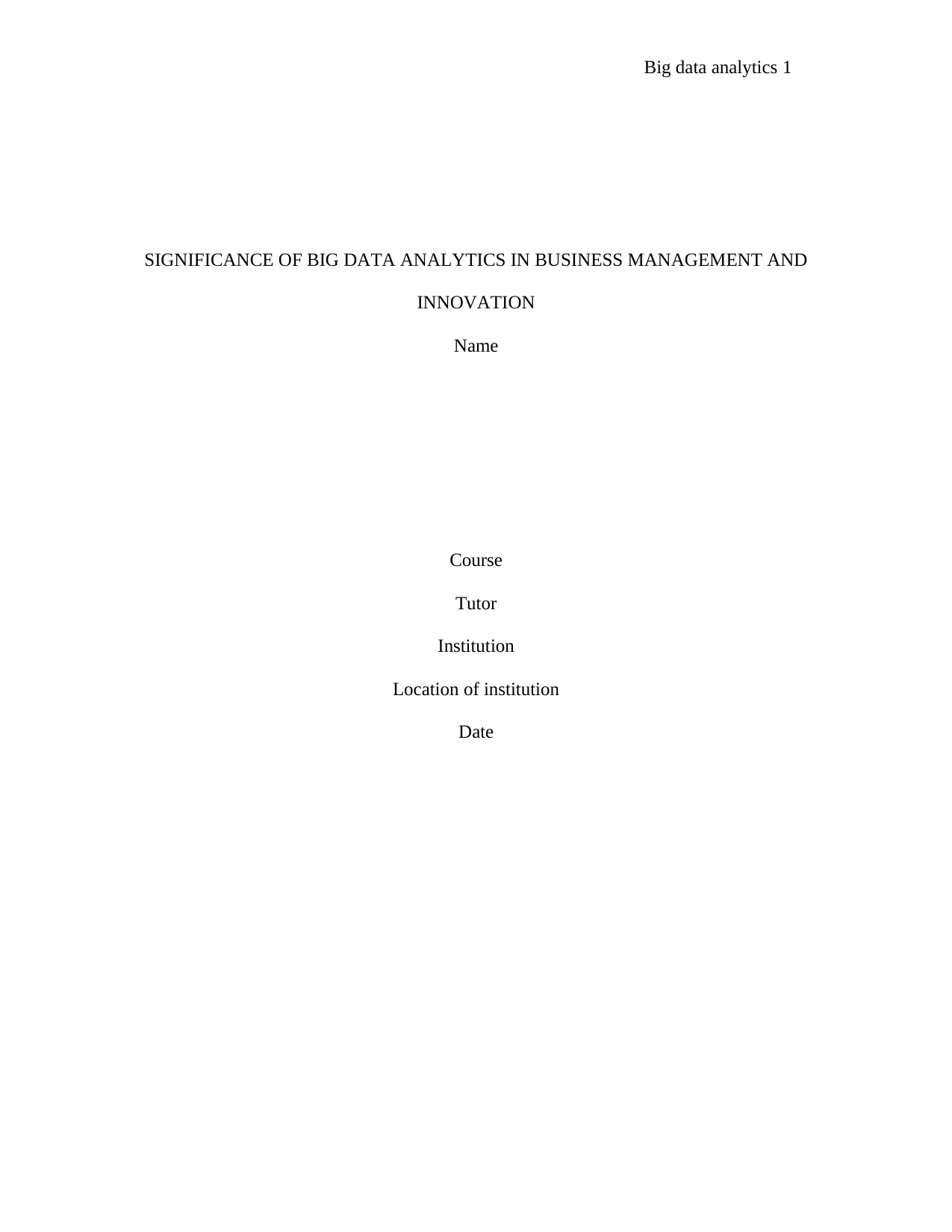
Big data analytics 1
SIGNIFICANCE OF BIG DATA ANALYTICS IN BUSINESS MANAGEMENT AND
INNOVATION
Name
Course
Tutor
Institution
Location of institution
Date
SIGNIFICANCE OF BIG DATA ANALYTICS IN BUSINESS MANAGEMENT AND
INNOVATION
Name
Course
Tutor
Institution
Location of institution
Date
Paraphrase This Document
Need a fresh take? Get an instant paraphrase of this document with our AI Paraphraser
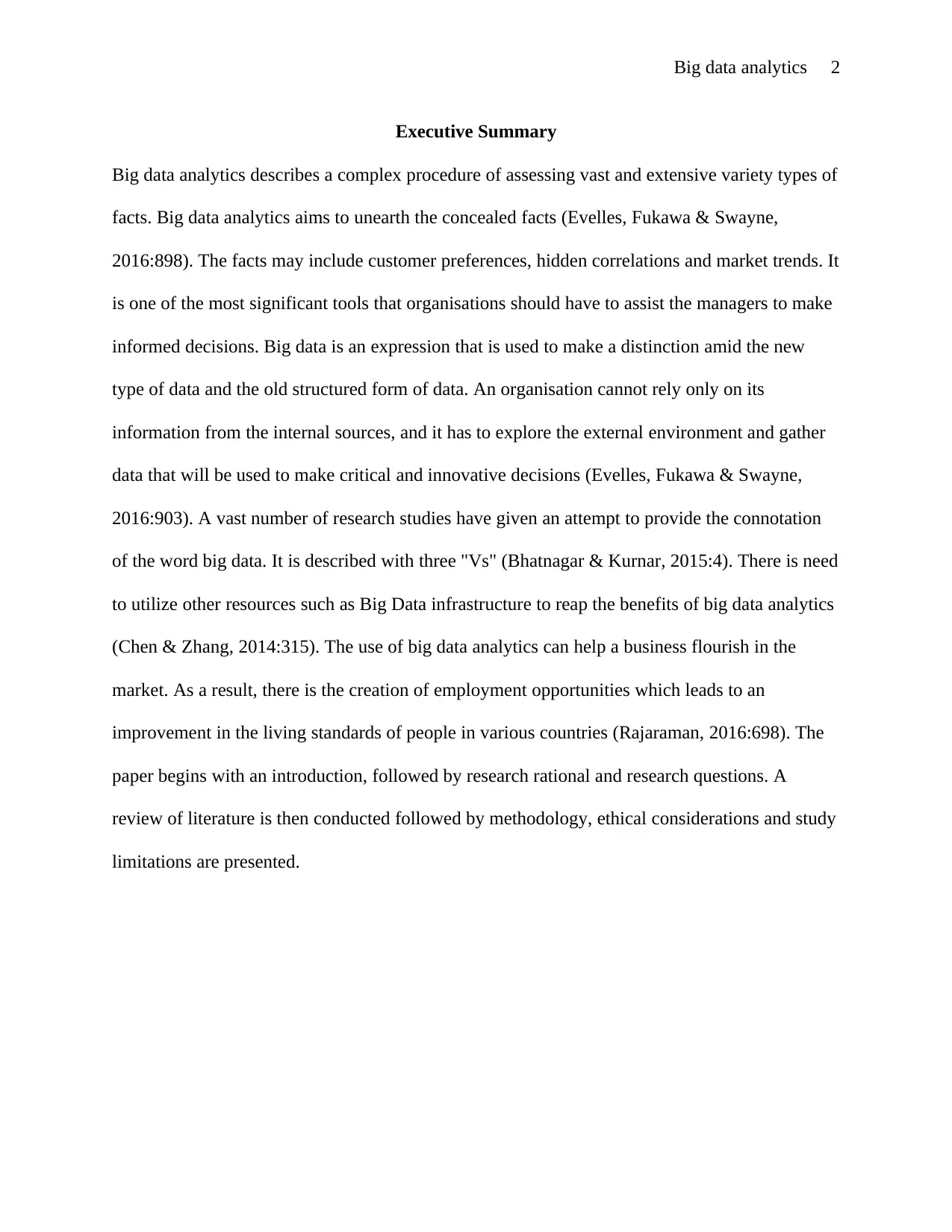
Big data analytics 2
Executive Summary
Big data analytics describes a complex procedure of assessing vast and extensive variety types of
facts. Big data analytics aims to unearth the concealed facts (Evelles, Fukawa & Swayne,
2016:898). The facts may include customer preferences, hidden correlations and market trends. It
is one of the most significant tools that organisations should have to assist the managers to make
informed decisions. Big data is an expression that is used to make a distinction amid the new
type of data and the old structured form of data. An organisation cannot rely only on its
information from the internal sources, and it has to explore the external environment and gather
data that will be used to make critical and innovative decisions (Evelles, Fukawa & Swayne,
2016:903). A vast number of research studies have given an attempt to provide the connotation
of the word big data. It is described with three "Vs" (Bhatnagar & Kurnar, 2015:4). There is need
to utilize other resources such as Big Data infrastructure to reap the benefits of big data analytics
(Chen & Zhang, 2014:315). The use of big data analytics can help a business flourish in the
market. As a result, there is the creation of employment opportunities which leads to an
improvement in the living standards of people in various countries (Rajaraman, 2016:698). The
paper begins with an introduction, followed by research rational and research questions. A
review of literature is then conducted followed by methodology, ethical considerations and study
limitations are presented.
Executive Summary
Big data analytics describes a complex procedure of assessing vast and extensive variety types of
facts. Big data analytics aims to unearth the concealed facts (Evelles, Fukawa & Swayne,
2016:898). The facts may include customer preferences, hidden correlations and market trends. It
is one of the most significant tools that organisations should have to assist the managers to make
informed decisions. Big data is an expression that is used to make a distinction amid the new
type of data and the old structured form of data. An organisation cannot rely only on its
information from the internal sources, and it has to explore the external environment and gather
data that will be used to make critical and innovative decisions (Evelles, Fukawa & Swayne,
2016:903). A vast number of research studies have given an attempt to provide the connotation
of the word big data. It is described with three "Vs" (Bhatnagar & Kurnar, 2015:4). There is need
to utilize other resources such as Big Data infrastructure to reap the benefits of big data analytics
(Chen & Zhang, 2014:315). The use of big data analytics can help a business flourish in the
market. As a result, there is the creation of employment opportunities which leads to an
improvement in the living standards of people in various countries (Rajaraman, 2016:698). The
paper begins with an introduction, followed by research rational and research questions. A
review of literature is then conducted followed by methodology, ethical considerations and study
limitations are presented.

Big data analytics 3
Table of Contents
Executive Summary.........................................................................................................................2
1.0. Introduction...........................................................................................................................4
Research Topic.............................................................................................................................4
The Significance of the Research Topic......................................................................................4
Rationale of the Research Project................................................................................................5
2.0. Research Questions...............................................................................................................6
General Research Question..........................................................................................................7
Specific Research Questions........................................................................................................7
3.0. Literature Review.................................................................................................................7
4.0. Methodology...........................................................................................................................10
4.1. Research Design..................................................................................................................10
4.2. Data collection....................................................................................................................11
4.3. Data Analysis......................................................................................................................11
4.4. Importance of the study.......................................................................................................11
5.0. Ethics......................................................................................................................................13
6.0. Limitations..............................................................................................................................13
7.0. Conclusion..............................................................................................................................13
7.0. Reference List.........................................................................................................................15
Table of Contents
Executive Summary.........................................................................................................................2
1.0. Introduction...........................................................................................................................4
Research Topic.............................................................................................................................4
The Significance of the Research Topic......................................................................................4
Rationale of the Research Project................................................................................................5
2.0. Research Questions...............................................................................................................6
General Research Question..........................................................................................................7
Specific Research Questions........................................................................................................7
3.0. Literature Review.................................................................................................................7
4.0. Methodology...........................................................................................................................10
4.1. Research Design..................................................................................................................10
4.2. Data collection....................................................................................................................11
4.3. Data Analysis......................................................................................................................11
4.4. Importance of the study.......................................................................................................11
5.0. Ethics......................................................................................................................................13
6.0. Limitations..............................................................................................................................13
7.0. Conclusion..............................................................................................................................13
7.0. Reference List.........................................................................................................................15
⊘ This is a preview!⊘
Do you want full access?
Subscribe today to unlock all pages.

Trusted by 1+ million students worldwide
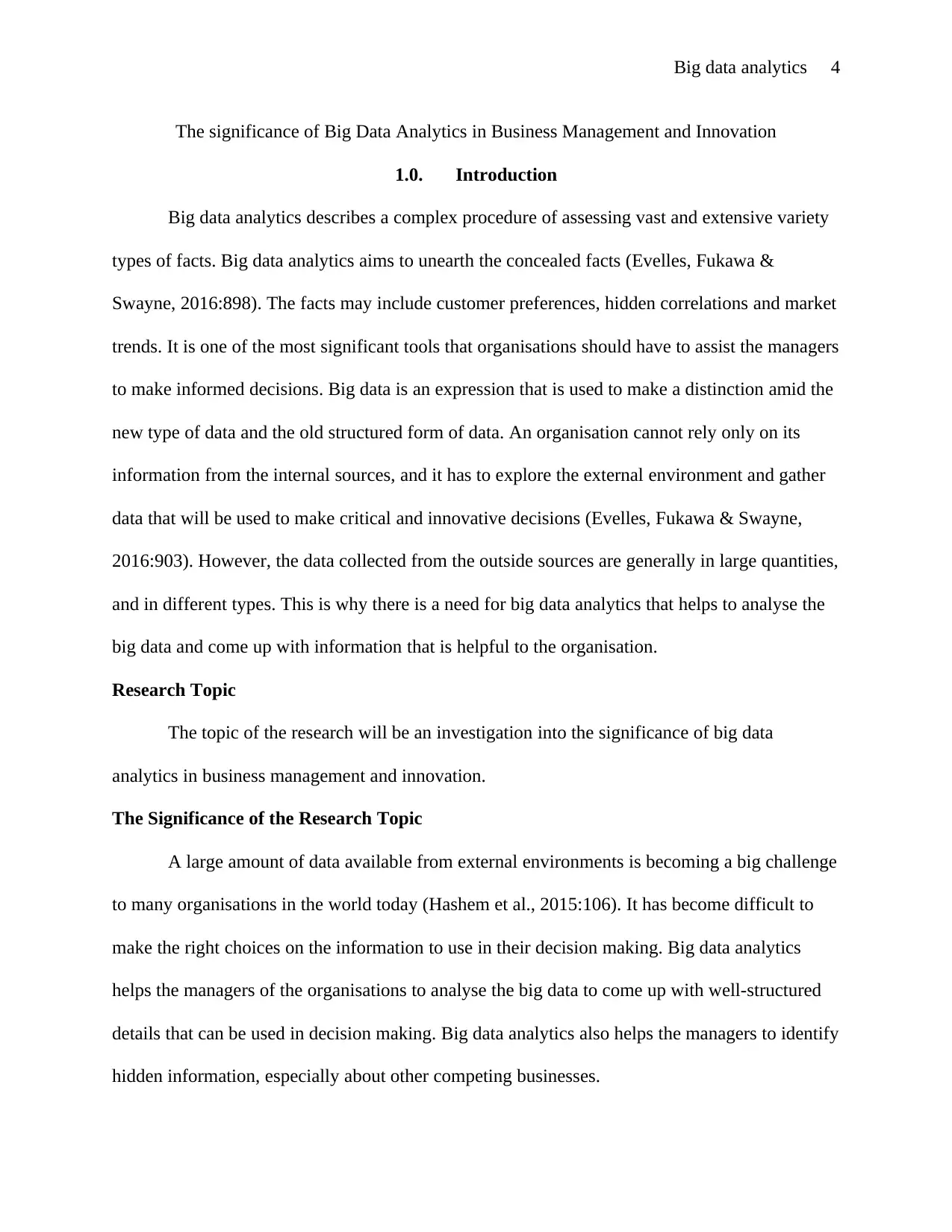
Big data analytics 4
The significance of Big Data Analytics in Business Management and Innovation
1.0. Introduction
Big data analytics describes a complex procedure of assessing vast and extensive variety
types of facts. Big data analytics aims to unearth the concealed facts (Evelles, Fukawa &
Swayne, 2016:898). The facts may include customer preferences, hidden correlations and market
trends. It is one of the most significant tools that organisations should have to assist the managers
to make informed decisions. Big data is an expression that is used to make a distinction amid the
new type of data and the old structured form of data. An organisation cannot rely only on its
information from the internal sources, and it has to explore the external environment and gather
data that will be used to make critical and innovative decisions (Evelles, Fukawa & Swayne,
2016:903). However, the data collected from the outside sources are generally in large quantities,
and in different types. This is why there is a need for big data analytics that helps to analyse the
big data and come up with information that is helpful to the organisation.
Research Topic
The topic of the research will be an investigation into the significance of big data
analytics in business management and innovation.
The Significance of the Research Topic
A large amount of data available from external environments is becoming a big challenge
to many organisations in the world today (Hashem et al., 2015:106). It has become difficult to
make the right choices on the information to use in their decision making. Big data analytics
helps the managers of the organisations to analyse the big data to come up with well-structured
details that can be used in decision making. Big data analytics also helps the managers to identify
hidden information, especially about other competing businesses.
The significance of Big Data Analytics in Business Management and Innovation
1.0. Introduction
Big data analytics describes a complex procedure of assessing vast and extensive variety
types of facts. Big data analytics aims to unearth the concealed facts (Evelles, Fukawa &
Swayne, 2016:898). The facts may include customer preferences, hidden correlations and market
trends. It is one of the most significant tools that organisations should have to assist the managers
to make informed decisions. Big data is an expression that is used to make a distinction amid the
new type of data and the old structured form of data. An organisation cannot rely only on its
information from the internal sources, and it has to explore the external environment and gather
data that will be used to make critical and innovative decisions (Evelles, Fukawa & Swayne,
2016:903). However, the data collected from the outside sources are generally in large quantities,
and in different types. This is why there is a need for big data analytics that helps to analyse the
big data and come up with information that is helpful to the organisation.
Research Topic
The topic of the research will be an investigation into the significance of big data
analytics in business management and innovation.
The Significance of the Research Topic
A large amount of data available from external environments is becoming a big challenge
to many organisations in the world today (Hashem et al., 2015:106). It has become difficult to
make the right choices on the information to use in their decision making. Big data analytics
helps the managers of the organisations to analyse the big data to come up with well-structured
details that can be used in decision making. Big data analytics also helps the managers to identify
hidden information, especially about other competing businesses.
Paraphrase This Document
Need a fresh take? Get an instant paraphrase of this document with our AI Paraphraser
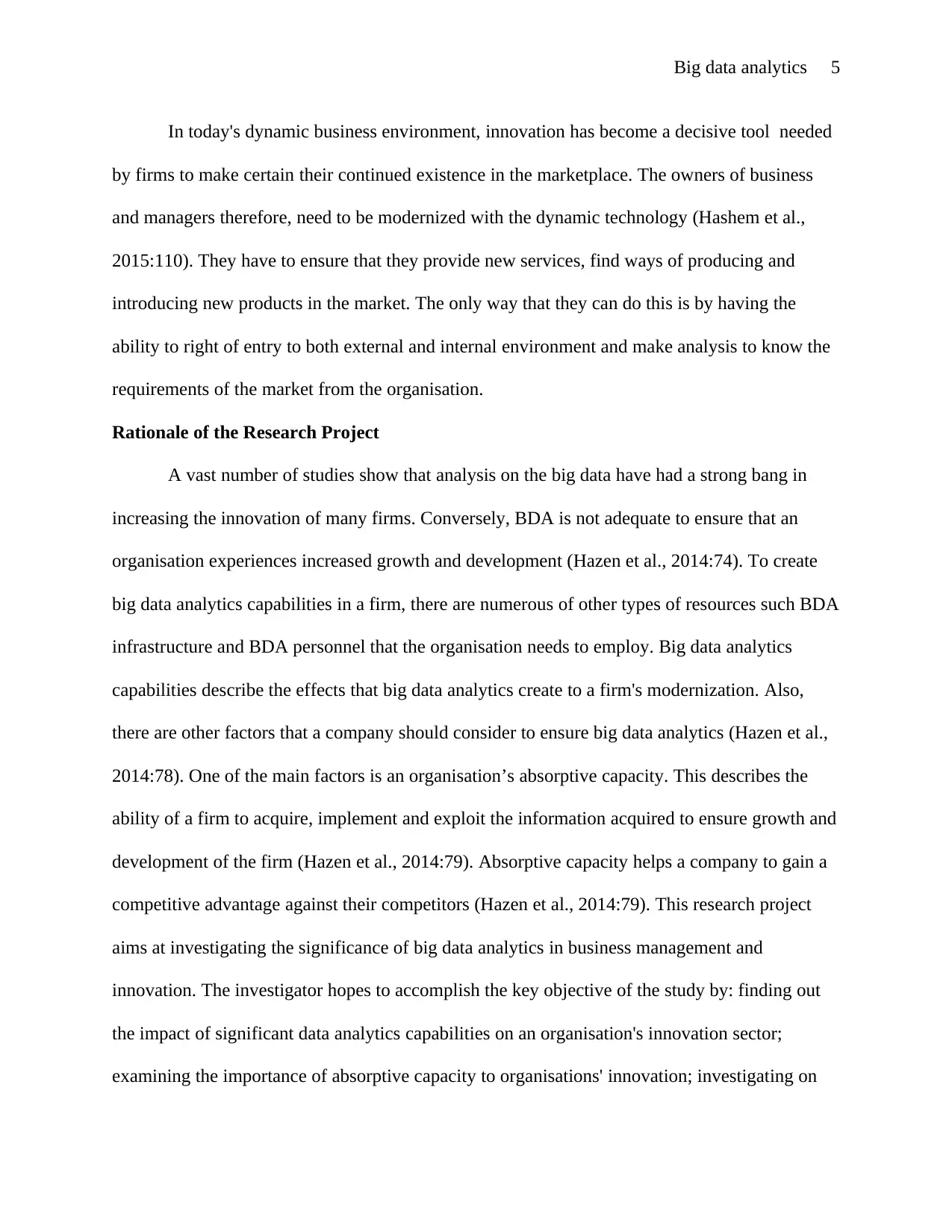
Big data analytics 5
In today's dynamic business environment, innovation has become a decisive tool needed
by firms to make certain their continued existence in the marketplace. The owners of business
and managers therefore, need to be modernized with the dynamic technology (Hashem et al.,
2015:110). They have to ensure that they provide new services, find ways of producing and
introducing new products in the market. The only way that they can do this is by having the
ability to right of entry to both external and internal environment and make analysis to know the
requirements of the market from the organisation.
Rationale of the Research Project
A vast number of studies show that analysis on the big data have had a strong bang in
increasing the innovation of many firms. Conversely, BDA is not adequate to ensure that an
organisation experiences increased growth and development (Hazen et al., 2014:74). To create
big data analytics capabilities in a firm, there are numerous of other types of resources such BDA
infrastructure and BDA personnel that the organisation needs to employ. Big data analytics
capabilities describe the effects that big data analytics create to a firm's modernization. Also,
there are other factors that a company should consider to ensure big data analytics (Hazen et al.,
2014:78). One of the main factors is an organisation’s absorptive capacity. This describes the
ability of a firm to acquire, implement and exploit the information acquired to ensure growth and
development of the firm (Hazen et al., 2014:79). Absorptive capacity helps a company to gain a
competitive advantage against their competitors (Hazen et al., 2014:79). This research project
aims at investigating the significance of big data analytics in business management and
innovation. The investigator hopes to accomplish the key objective of the study by: finding out
the impact of significant data analytics capabilities on an organisation's innovation sector;
examining the importance of absorptive capacity to organisations' innovation; investigating on
In today's dynamic business environment, innovation has become a decisive tool needed
by firms to make certain their continued existence in the marketplace. The owners of business
and managers therefore, need to be modernized with the dynamic technology (Hashem et al.,
2015:110). They have to ensure that they provide new services, find ways of producing and
introducing new products in the market. The only way that they can do this is by having the
ability to right of entry to both external and internal environment and make analysis to know the
requirements of the market from the organisation.
Rationale of the Research Project
A vast number of studies show that analysis on the big data have had a strong bang in
increasing the innovation of many firms. Conversely, BDA is not adequate to ensure that an
organisation experiences increased growth and development (Hazen et al., 2014:74). To create
big data analytics capabilities in a firm, there are numerous of other types of resources such BDA
infrastructure and BDA personnel that the organisation needs to employ. Big data analytics
capabilities describe the effects that big data analytics create to a firm's modernization. Also,
there are other factors that a company should consider to ensure big data analytics (Hazen et al.,
2014:78). One of the main factors is an organisation’s absorptive capacity. This describes the
ability of a firm to acquire, implement and exploit the information acquired to ensure growth and
development of the firm (Hazen et al., 2014:79). Absorptive capacity helps a company to gain a
competitive advantage against their competitors (Hazen et al., 2014:79). This research project
aims at investigating the significance of big data analytics in business management and
innovation. The investigator hopes to accomplish the key objective of the study by: finding out
the impact of significant data analytics capabilities on an organisation's innovation sector;
examining the importance of absorptive capacity to organisations' innovation; investigating on
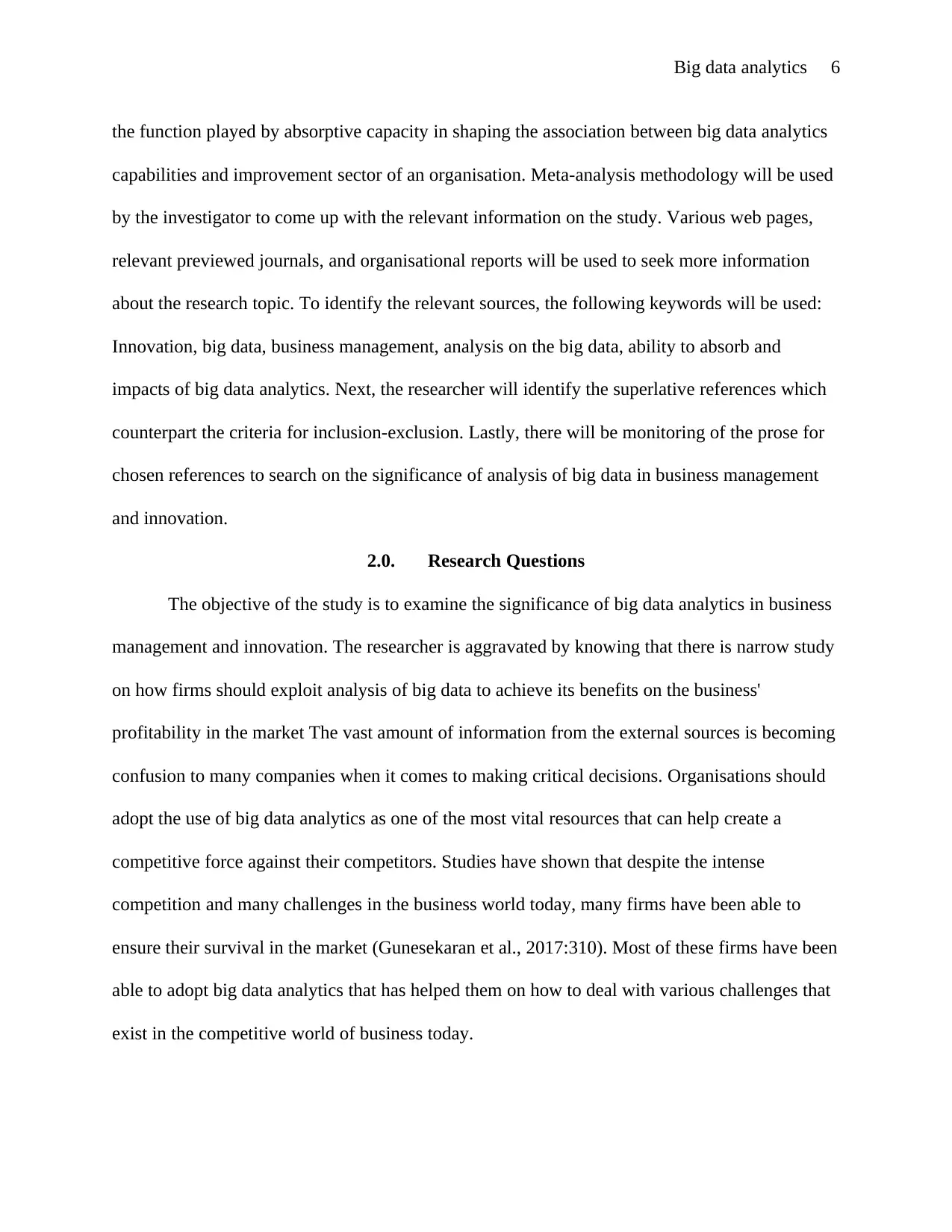
Big data analytics 6
the function played by absorptive capacity in shaping the association between big data analytics
capabilities and improvement sector of an organisation. Meta-analysis methodology will be used
by the investigator to come up with the relevant information on the study. Various web pages,
relevant previewed journals, and organisational reports will be used to seek more information
about the research topic. To identify the relevant sources, the following keywords will be used:
Innovation, big data, business management, analysis on the big data, ability to absorb and
impacts of big data analytics. Next, the researcher will identify the superlative references which
counterpart the criteria for inclusion-exclusion. Lastly, there will be monitoring of the prose for
chosen references to search on the significance of analysis of big data in business management
and innovation.
2.0. Research Questions
The objective of the study is to examine the significance of big data analytics in business
management and innovation. The researcher is aggravated by knowing that there is narrow study
on how firms should exploit analysis of big data to achieve its benefits on the business'
profitability in the market The vast amount of information from the external sources is becoming
confusion to many companies when it comes to making critical decisions. Organisations should
adopt the use of big data analytics as one of the most vital resources that can help create a
competitive force against their competitors. Studies have shown that despite the intense
competition and many challenges in the business world today, many firms have been able to
ensure their survival in the market (Gunesekaran et al., 2017:310). Most of these firms have been
able to adopt big data analytics that has helped them on how to deal with various challenges that
exist in the competitive world of business today.
the function played by absorptive capacity in shaping the association between big data analytics
capabilities and improvement sector of an organisation. Meta-analysis methodology will be used
by the investigator to come up with the relevant information on the study. Various web pages,
relevant previewed journals, and organisational reports will be used to seek more information
about the research topic. To identify the relevant sources, the following keywords will be used:
Innovation, big data, business management, analysis on the big data, ability to absorb and
impacts of big data analytics. Next, the researcher will identify the superlative references which
counterpart the criteria for inclusion-exclusion. Lastly, there will be monitoring of the prose for
chosen references to search on the significance of analysis of big data in business management
and innovation.
2.0. Research Questions
The objective of the study is to examine the significance of big data analytics in business
management and innovation. The researcher is aggravated by knowing that there is narrow study
on how firms should exploit analysis of big data to achieve its benefits on the business'
profitability in the market The vast amount of information from the external sources is becoming
confusion to many companies when it comes to making critical decisions. Organisations should
adopt the use of big data analytics as one of the most vital resources that can help create a
competitive force against their competitors. Studies have shown that despite the intense
competition and many challenges in the business world today, many firms have been able to
ensure their survival in the market (Gunesekaran et al., 2017:310). Most of these firms have been
able to adopt big data analytics that has helped them on how to deal with various challenges that
exist in the competitive world of business today.
⊘ This is a preview!⊘
Do you want full access?
Subscribe today to unlock all pages.

Trusted by 1+ million students worldwide
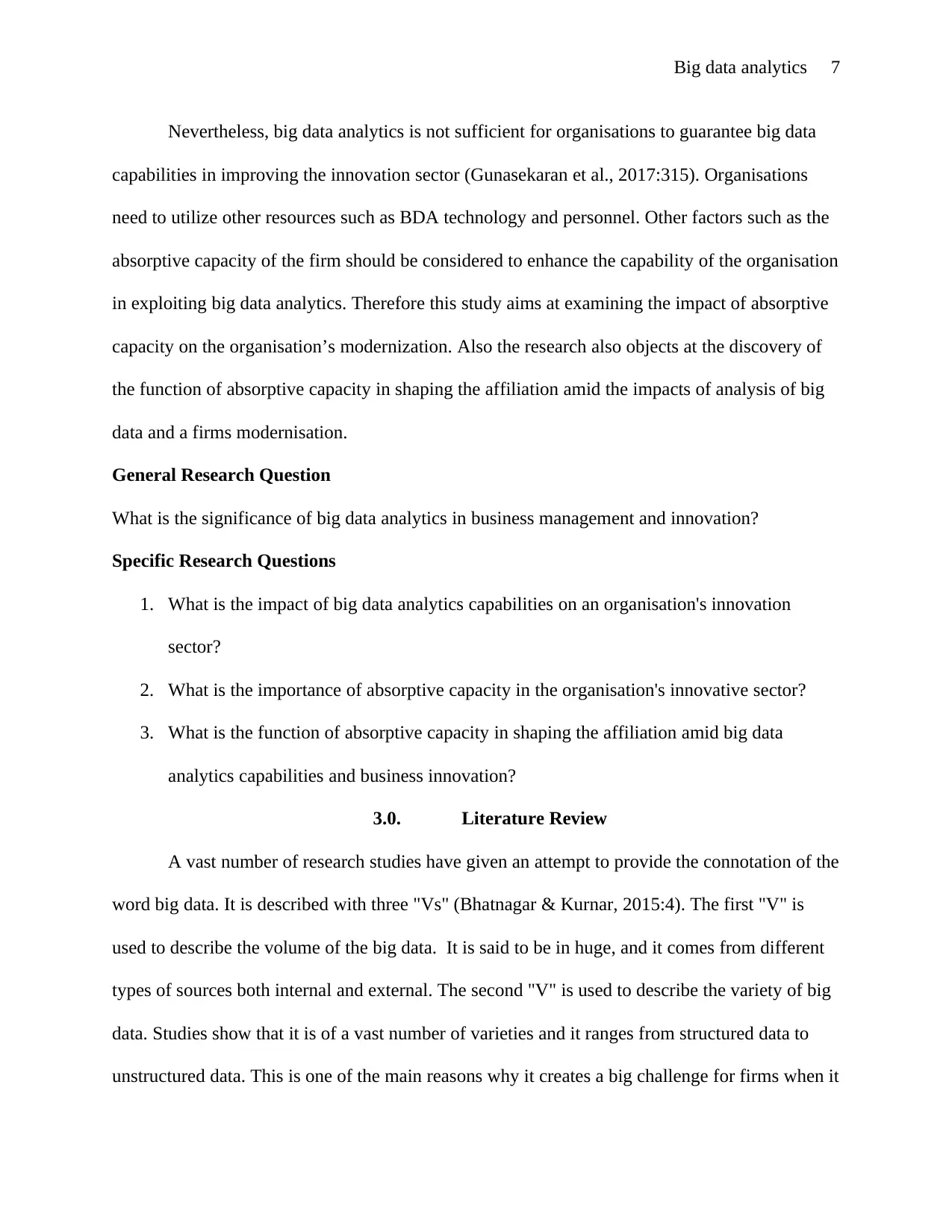
Big data analytics 7
Nevertheless, big data analytics is not sufficient for organisations to guarantee big data
capabilities in improving the innovation sector (Gunasekaran et al., 2017:315). Organisations
need to utilize other resources such as BDA technology and personnel. Other factors such as the
absorptive capacity of the firm should be considered to enhance the capability of the organisation
in exploiting big data analytics. Therefore this study aims at examining the impact of absorptive
capacity on the organisation’s modernization. Also the research also objects at the discovery of
the function of absorptive capacity in shaping the affiliation amid the impacts of analysis of big
data and a firms modernisation.
General Research Question
What is the significance of big data analytics in business management and innovation?
Specific Research Questions
1. What is the impact of big data analytics capabilities on an organisation's innovation
sector?
2. What is the importance of absorptive capacity in the organisation's innovative sector?
3. What is the function of absorptive capacity in shaping the affiliation amid big data
analytics capabilities and business innovation?
3.0. Literature Review
A vast number of research studies have given an attempt to provide the connotation of the
word big data. It is described with three "Vs" (Bhatnagar & Kurnar, 2015:4). The first "V" is
used to describe the volume of the big data. It is said to be in huge, and it comes from different
types of sources both internal and external. The second "V" is used to describe the variety of big
data. Studies show that it is of a vast number of varieties and it ranges from structured data to
unstructured data. This is one of the main reasons why it creates a big challenge for firms when it
Nevertheless, big data analytics is not sufficient for organisations to guarantee big data
capabilities in improving the innovation sector (Gunasekaran et al., 2017:315). Organisations
need to utilize other resources such as BDA technology and personnel. Other factors such as the
absorptive capacity of the firm should be considered to enhance the capability of the organisation
in exploiting big data analytics. Therefore this study aims at examining the impact of absorptive
capacity on the organisation’s modernization. Also the research also objects at the discovery of
the function of absorptive capacity in shaping the affiliation amid the impacts of analysis of big
data and a firms modernisation.
General Research Question
What is the significance of big data analytics in business management and innovation?
Specific Research Questions
1. What is the impact of big data analytics capabilities on an organisation's innovation
sector?
2. What is the importance of absorptive capacity in the organisation's innovative sector?
3. What is the function of absorptive capacity in shaping the affiliation amid big data
analytics capabilities and business innovation?
3.0. Literature Review
A vast number of research studies have given an attempt to provide the connotation of the
word big data. It is described with three "Vs" (Bhatnagar & Kurnar, 2015:4). The first "V" is
used to describe the volume of the big data. It is said to be in huge, and it comes from different
types of sources both internal and external. The second "V" is used to describe the variety of big
data. Studies show that it is of a vast number of varieties and it ranges from structured data to
unstructured data. This is one of the main reasons why it creates a big challenge for firms when it
Paraphrase This Document
Need a fresh take? Get an instant paraphrase of this document with our AI Paraphraser
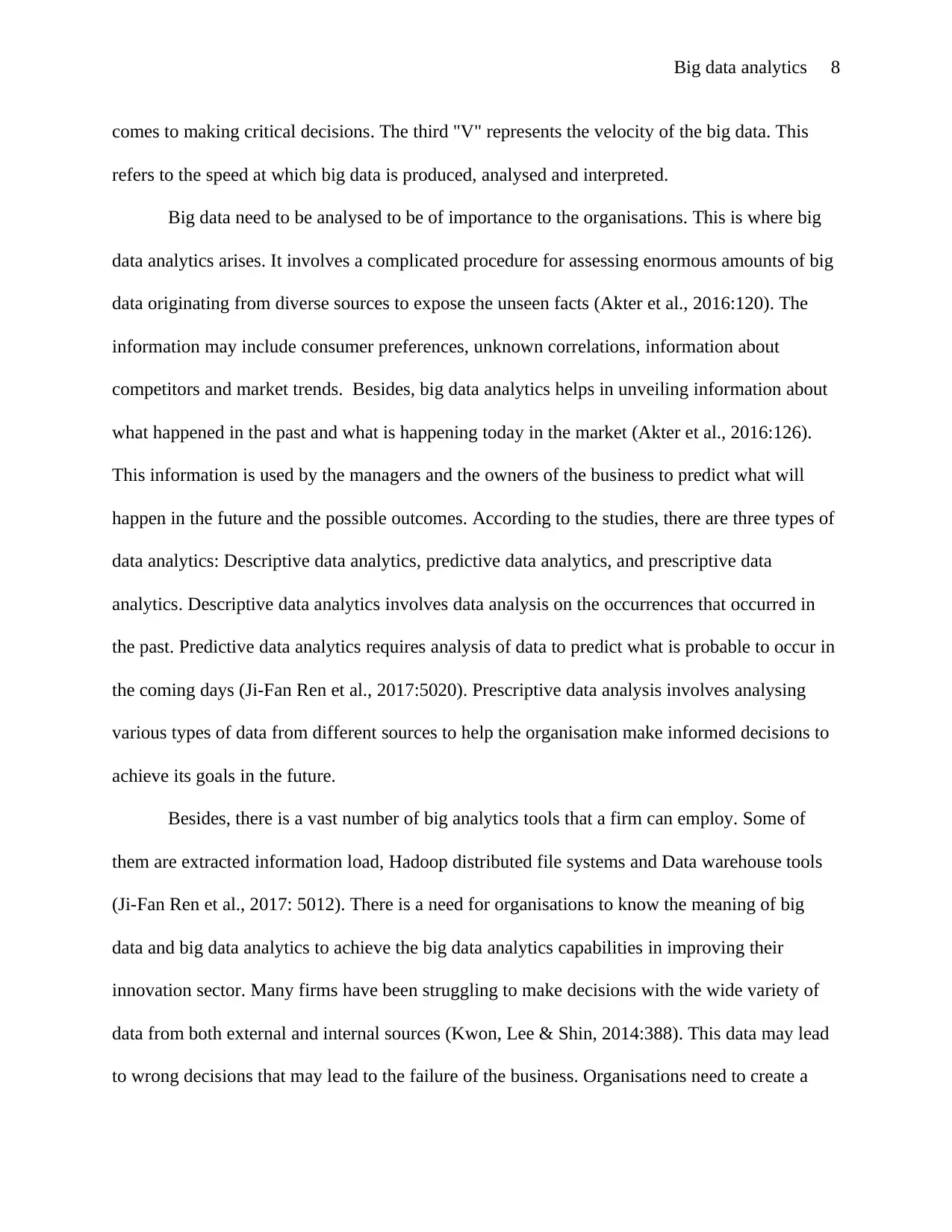
Big data analytics 8
comes to making critical decisions. The third "V" represents the velocity of the big data. This
refers to the speed at which big data is produced, analysed and interpreted.
Big data need to be analysed to be of importance to the organisations. This is where big
data analytics arises. It involves a complicated procedure for assessing enormous amounts of big
data originating from diverse sources to expose the unseen facts (Akter et al., 2016:120). The
information may include consumer preferences, unknown correlations, information about
competitors and market trends. Besides, big data analytics helps in unveiling information about
what happened in the past and what is happening today in the market (Akter et al., 2016:126).
This information is used by the managers and the owners of the business to predict what will
happen in the future and the possible outcomes. According to the studies, there are three types of
data analytics: Descriptive data analytics, predictive data analytics, and prescriptive data
analytics. Descriptive data analytics involves data analysis on the occurrences that occurred in
the past. Predictive data analytics requires analysis of data to predict what is probable to occur in
the coming days (Ji-Fan Ren et al., 2017:5020). Prescriptive data analysis involves analysing
various types of data from different sources to help the organisation make informed decisions to
achieve its goals in the future.
Besides, there is a vast number of big analytics tools that a firm can employ. Some of
them are extracted information load, Hadoop distributed file systems and Data warehouse tools
(Ji-Fan Ren et al., 2017: 5012). There is a need for organisations to know the meaning of big
data and big data analytics to achieve the big data analytics capabilities in improving their
innovation sector. Many firms have been struggling to make decisions with the wide variety of
data from both external and internal sources (Kwon, Lee & Shin, 2014:388). This data may lead
to wrong decisions that may lead to the failure of the business. Organisations need to create a
comes to making critical decisions. The third "V" represents the velocity of the big data. This
refers to the speed at which big data is produced, analysed and interpreted.
Big data need to be analysed to be of importance to the organisations. This is where big
data analytics arises. It involves a complicated procedure for assessing enormous amounts of big
data originating from diverse sources to expose the unseen facts (Akter et al., 2016:120). The
information may include consumer preferences, unknown correlations, information about
competitors and market trends. Besides, big data analytics helps in unveiling information about
what happened in the past and what is happening today in the market (Akter et al., 2016:126).
This information is used by the managers and the owners of the business to predict what will
happen in the future and the possible outcomes. According to the studies, there are three types of
data analytics: Descriptive data analytics, predictive data analytics, and prescriptive data
analytics. Descriptive data analytics involves data analysis on the occurrences that occurred in
the past. Predictive data analytics requires analysis of data to predict what is probable to occur in
the coming days (Ji-Fan Ren et al., 2017:5020). Prescriptive data analysis involves analysing
various types of data from different sources to help the organisation make informed decisions to
achieve its goals in the future.
Besides, there is a vast number of big analytics tools that a firm can employ. Some of
them are extracted information load, Hadoop distributed file systems and Data warehouse tools
(Ji-Fan Ren et al., 2017: 5012). There is a need for organisations to know the meaning of big
data and big data analytics to achieve the big data analytics capabilities in improving their
innovation sector. Many firms have been struggling to make decisions with the wide variety of
data from both external and internal sources (Kwon, Lee & Shin, 2014:388). This data may lead
to wrong decisions that may lead to the failure of the business. Organisations need to create a
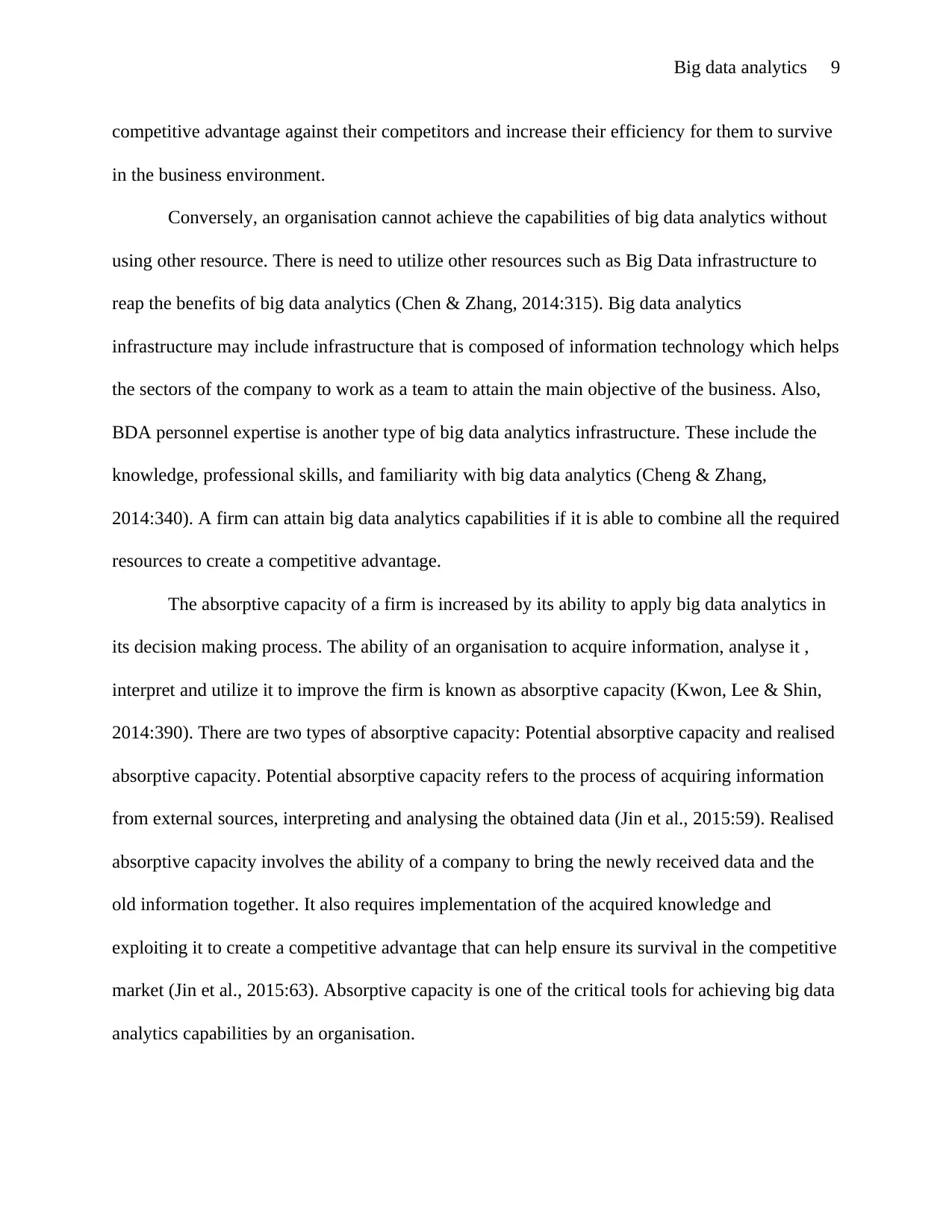
Big data analytics 9
competitive advantage against their competitors and increase their efficiency for them to survive
in the business environment.
Conversely, an organisation cannot achieve the capabilities of big data analytics without
using other resource. There is need to utilize other resources such as Big Data infrastructure to
reap the benefits of big data analytics (Chen & Zhang, 2014:315). Big data analytics
infrastructure may include infrastructure that is composed of information technology which helps
the sectors of the company to work as a team to attain the main objective of the business. Also,
BDA personnel expertise is another type of big data analytics infrastructure. These include the
knowledge, professional skills, and familiarity with big data analytics (Cheng & Zhang,
2014:340). A firm can attain big data analytics capabilities if it is able to combine all the required
resources to create a competitive advantage.
The absorptive capacity of a firm is increased by its ability to apply big data analytics in
its decision making process. The ability of an organisation to acquire information, analyse it ,
interpret and utilize it to improve the firm is known as absorptive capacity (Kwon, Lee & Shin,
2014:390). There are two types of absorptive capacity: Potential absorptive capacity and realised
absorptive capacity. Potential absorptive capacity refers to the process of acquiring information
from external sources, interpreting and analysing the obtained data (Jin et al., 2015:59). Realised
absorptive capacity involves the ability of a company to bring the newly received data and the
old information together. It also requires implementation of the acquired knowledge and
exploiting it to create a competitive advantage that can help ensure its survival in the competitive
market (Jin et al., 2015:63). Absorptive capacity is one of the critical tools for achieving big data
analytics capabilities by an organisation.
competitive advantage against their competitors and increase their efficiency for them to survive
in the business environment.
Conversely, an organisation cannot achieve the capabilities of big data analytics without
using other resource. There is need to utilize other resources such as Big Data infrastructure to
reap the benefits of big data analytics (Chen & Zhang, 2014:315). Big data analytics
infrastructure may include infrastructure that is composed of information technology which helps
the sectors of the company to work as a team to attain the main objective of the business. Also,
BDA personnel expertise is another type of big data analytics infrastructure. These include the
knowledge, professional skills, and familiarity with big data analytics (Cheng & Zhang,
2014:340). A firm can attain big data analytics capabilities if it is able to combine all the required
resources to create a competitive advantage.
The absorptive capacity of a firm is increased by its ability to apply big data analytics in
its decision making process. The ability of an organisation to acquire information, analyse it ,
interpret and utilize it to improve the firm is known as absorptive capacity (Kwon, Lee & Shin,
2014:390). There are two types of absorptive capacity: Potential absorptive capacity and realised
absorptive capacity. Potential absorptive capacity refers to the process of acquiring information
from external sources, interpreting and analysing the obtained data (Jin et al., 2015:59). Realised
absorptive capacity involves the ability of a company to bring the newly received data and the
old information together. It also requires implementation of the acquired knowledge and
exploiting it to create a competitive advantage that can help ensure its survival in the competitive
market (Jin et al., 2015:63). Absorptive capacity is one of the critical tools for achieving big data
analytics capabilities by an organisation.
⊘ This is a preview!⊘
Do you want full access?
Subscribe today to unlock all pages.

Trusted by 1+ million students worldwide
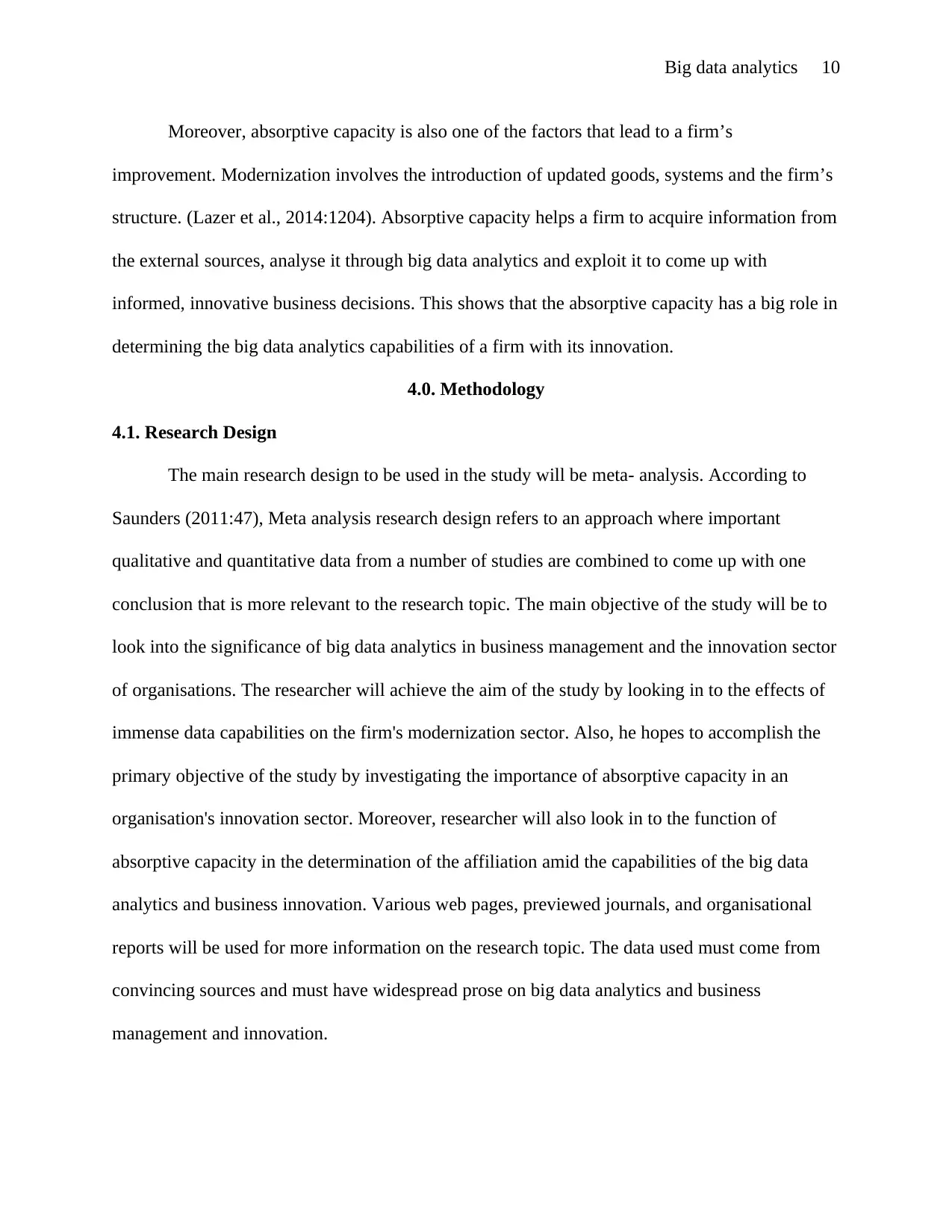
Big data analytics 10
Moreover, absorptive capacity is also one of the factors that lead to a firm’s
improvement. Modernization involves the introduction of updated goods, systems and the firm’s
structure. (Lazer et al., 2014:1204). Absorptive capacity helps a firm to acquire information from
the external sources, analyse it through big data analytics and exploit it to come up with
informed, innovative business decisions. This shows that the absorptive capacity has a big role in
determining the big data analytics capabilities of a firm with its innovation.
4.0. Methodology
4.1. Research Design
The main research design to be used in the study will be meta- analysis. According to
Saunders (2011:47), Meta analysis research design refers to an approach where important
qualitative and quantitative data from a number of studies are combined to come up with one
conclusion that is more relevant to the research topic. The main objective of the study will be to
look into the significance of big data analytics in business management and the innovation sector
of organisations. The researcher will achieve the aim of the study by looking in to the effects of
immense data capabilities on the firm's modernization sector. Also, he hopes to accomplish the
primary objective of the study by investigating the importance of absorptive capacity in an
organisation's innovation sector. Moreover, researcher will also look in to the function of
absorptive capacity in the determination of the affiliation amid the capabilities of the big data
analytics and business innovation. Various web pages, previewed journals, and organisational
reports will be used for more information on the research topic. The data used must come from
convincing sources and must have widespread prose on big data analytics and business
management and innovation.
Moreover, absorptive capacity is also one of the factors that lead to a firm’s
improvement. Modernization involves the introduction of updated goods, systems and the firm’s
structure. (Lazer et al., 2014:1204). Absorptive capacity helps a firm to acquire information from
the external sources, analyse it through big data analytics and exploit it to come up with
informed, innovative business decisions. This shows that the absorptive capacity has a big role in
determining the big data analytics capabilities of a firm with its innovation.
4.0. Methodology
4.1. Research Design
The main research design to be used in the study will be meta- analysis. According to
Saunders (2011:47), Meta analysis research design refers to an approach where important
qualitative and quantitative data from a number of studies are combined to come up with one
conclusion that is more relevant to the research topic. The main objective of the study will be to
look into the significance of big data analytics in business management and the innovation sector
of organisations. The researcher will achieve the aim of the study by looking in to the effects of
immense data capabilities on the firm's modernization sector. Also, he hopes to accomplish the
primary objective of the study by investigating the importance of absorptive capacity in an
organisation's innovation sector. Moreover, researcher will also look in to the function of
absorptive capacity in the determination of the affiliation amid the capabilities of the big data
analytics and business innovation. Various web pages, previewed journals, and organisational
reports will be used for more information on the research topic. The data used must come from
convincing sources and must have widespread prose on big data analytics and business
management and innovation.
Paraphrase This Document
Need a fresh take? Get an instant paraphrase of this document with our AI Paraphraser
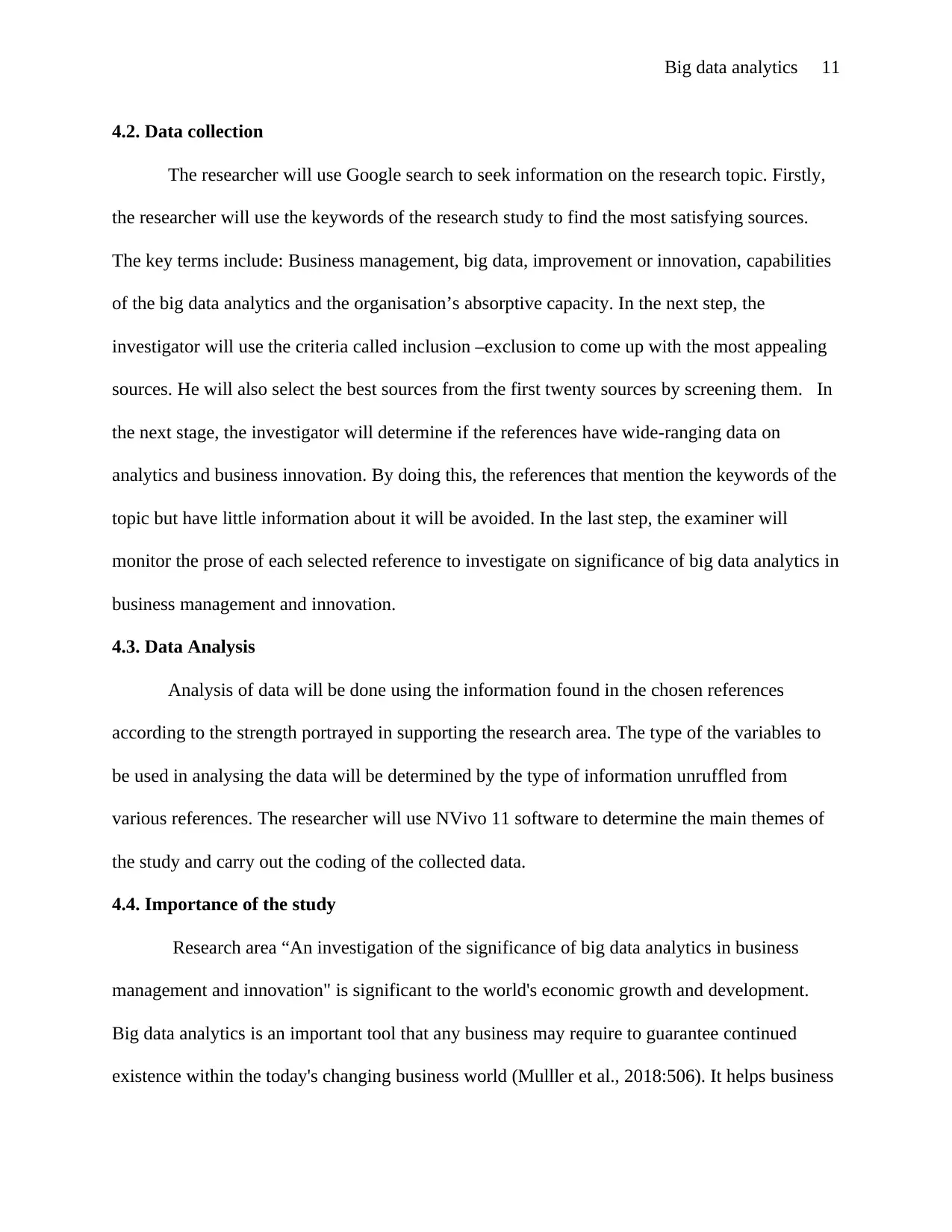
Big data analytics 11
4.2. Data collection
The researcher will use Google search to seek information on the research topic. Firstly,
the researcher will use the keywords of the research study to find the most satisfying sources.
The key terms include: Business management, big data, improvement or innovation, capabilities
of the big data analytics and the organisation’s absorptive capacity. In the next step, the
investigator will use the criteria called inclusion –exclusion to come up with the most appealing
sources. He will also select the best sources from the first twenty sources by screening them. In
the next stage, the investigator will determine if the references have wide-ranging data on
analytics and business innovation. By doing this, the references that mention the keywords of the
topic but have little information about it will be avoided. In the last step, the examiner will
monitor the prose of each selected reference to investigate on significance of big data analytics in
business management and innovation.
4.3. Data Analysis
Analysis of data will be done using the information found in the chosen references
according to the strength portrayed in supporting the research area. The type of the variables to
be used in analysing the data will be determined by the type of information unruffled from
various references. The researcher will use NVivo 11 software to determine the main themes of
the study and carry out the coding of the collected data.
4.4. Importance of the study
Research area “An investigation of the significance of big data analytics in business
management and innovation" is significant to the world's economic growth and development.
Big data analytics is an important tool that any business may require to guarantee continued
existence within the today's changing business world (Mulller et al., 2018:506). It helps business
4.2. Data collection
The researcher will use Google search to seek information on the research topic. Firstly,
the researcher will use the keywords of the research study to find the most satisfying sources.
The key terms include: Business management, big data, improvement or innovation, capabilities
of the big data analytics and the organisation’s absorptive capacity. In the next step, the
investigator will use the criteria called inclusion –exclusion to come up with the most appealing
sources. He will also select the best sources from the first twenty sources by screening them. In
the next stage, the investigator will determine if the references have wide-ranging data on
analytics and business innovation. By doing this, the references that mention the keywords of the
topic but have little information about it will be avoided. In the last step, the examiner will
monitor the prose of each selected reference to investigate on significance of big data analytics in
business management and innovation.
4.3. Data Analysis
Analysis of data will be done using the information found in the chosen references
according to the strength portrayed in supporting the research area. The type of the variables to
be used in analysing the data will be determined by the type of information unruffled from
various references. The researcher will use NVivo 11 software to determine the main themes of
the study and carry out the coding of the collected data.
4.4. Importance of the study
Research area “An investigation of the significance of big data analytics in business
management and innovation" is significant to the world's economic growth and development.
Big data analytics is an important tool that any business may require to guarantee continued
existence within the today's changing business world (Mulller et al., 2018:506). It helps business
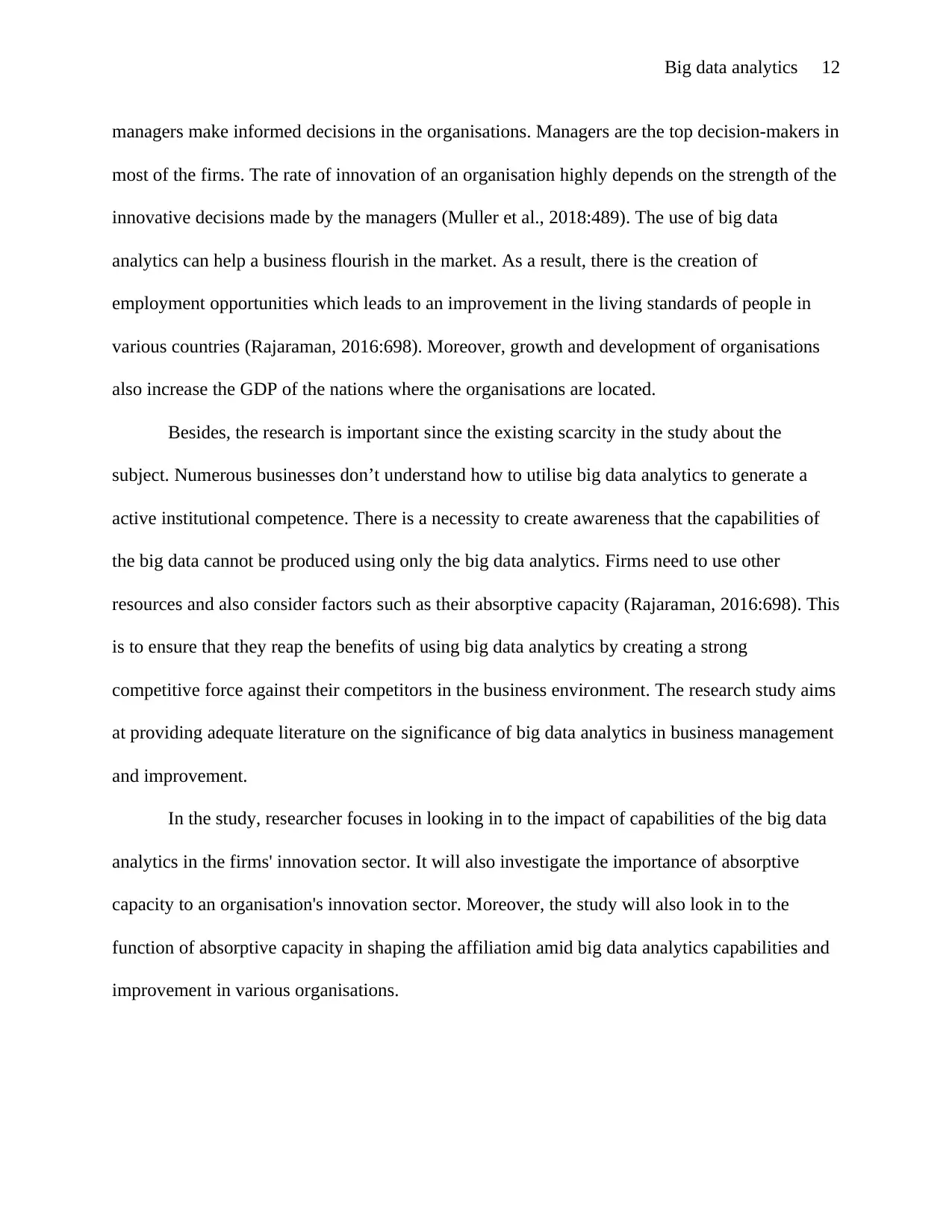
Big data analytics 12
managers make informed decisions in the organisations. Managers are the top decision-makers in
most of the firms. The rate of innovation of an organisation highly depends on the strength of the
innovative decisions made by the managers (Muller et al., 2018:489). The use of big data
analytics can help a business flourish in the market. As a result, there is the creation of
employment opportunities which leads to an improvement in the living standards of people in
various countries (Rajaraman, 2016:698). Moreover, growth and development of organisations
also increase the GDP of the nations where the organisations are located.
Besides, the research is important since the existing scarcity in the study about the
subject. Numerous businesses don’t understand how to utilise big data analytics to generate a
active institutional competence. There is a necessity to create awareness that the capabilities of
the big data cannot be produced using only the big data analytics. Firms need to use other
resources and also consider factors such as their absorptive capacity (Rajaraman, 2016:698). This
is to ensure that they reap the benefits of using big data analytics by creating a strong
competitive force against their competitors in the business environment. The research study aims
at providing adequate literature on the significance of big data analytics in business management
and improvement.
In the study, researcher focuses in looking in to the impact of capabilities of the big data
analytics in the firms' innovation sector. It will also investigate the importance of absorptive
capacity to an organisation's innovation sector. Moreover, the study will also look in to the
function of absorptive capacity in shaping the affiliation amid big data analytics capabilities and
improvement in various organisations.
managers make informed decisions in the organisations. Managers are the top decision-makers in
most of the firms. The rate of innovation of an organisation highly depends on the strength of the
innovative decisions made by the managers (Muller et al., 2018:489). The use of big data
analytics can help a business flourish in the market. As a result, there is the creation of
employment opportunities which leads to an improvement in the living standards of people in
various countries (Rajaraman, 2016:698). Moreover, growth and development of organisations
also increase the GDP of the nations where the organisations are located.
Besides, the research is important since the existing scarcity in the study about the
subject. Numerous businesses don’t understand how to utilise big data analytics to generate a
active institutional competence. There is a necessity to create awareness that the capabilities of
the big data cannot be produced using only the big data analytics. Firms need to use other
resources and also consider factors such as their absorptive capacity (Rajaraman, 2016:698). This
is to ensure that they reap the benefits of using big data analytics by creating a strong
competitive force against their competitors in the business environment. The research study aims
at providing adequate literature on the significance of big data analytics in business management
and improvement.
In the study, researcher focuses in looking in to the impact of capabilities of the big data
analytics in the firms' innovation sector. It will also investigate the importance of absorptive
capacity to an organisation's innovation sector. Moreover, the study will also look in to the
function of absorptive capacity in shaping the affiliation amid big data analytics capabilities and
improvement in various organisations.
⊘ This is a preview!⊘
Do you want full access?
Subscribe today to unlock all pages.

Trusted by 1+ million students worldwide
1 out of 17
Your All-in-One AI-Powered Toolkit for Academic Success.
+13062052269
info@desklib.com
Available 24*7 on WhatsApp / Email
![[object Object]](/_next/static/media/star-bottom.7253800d.svg)
Unlock your academic potential
Copyright © 2020–2025 A2Z Services. All Rights Reserved. Developed and managed by ZUCOL.


